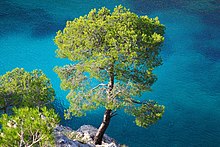Aleppo pine
| Pinus halepensis | |
|---|---|
 |
|
| P. halepensis on the Calanque de Port-Pin, France | |
| Scientific classification | |
| Kingdom: | Plantae |
| Division: | Pinophyta |
| Class: | Pinopsida |
| Order: | Pinales |
| Family: | Pinaceae |
| Genus: | Pinus |
| Subgenus: | Pinus |
| Species: | P. halepensis |
| Binomial name | |
|
Pinus halepensis Miller |
|
 |
|
| Distribution map | |
Pinus halepensis, commonly known as the Aleppo pine, is a pine native to the Mediterranean region. Its range extends from Morocco, Algeria and Spain north to southern France, Italy, Croatia, Montenegro, Albania, and east to Greece, all over Malta and northern Tunisia, with an outlying population (from which it was first described) in Syria, Lebanon, southern Turkey, Jordan, Israel, and Palestinian territories. In Israel it is called Jerusalem pine.
Pinus halepensis, the Aleppo pine, is generally found at low altitudes, mostly from sea level to 200 m (660 ft), but can grow up to 1,000 m (3,300 ft) in southern Spain, well over 1,200 m (3,900 ft) on Crete, and up to 1,700 m (5,600 ft) in the south, in Morocco, Algeria and Tunisia. The tree is able to quickly colonize open and disturbed areas. It can grow on all substrates and almost in all bioclimates in the Mediterranean.
P. halepensis is a small to medium-sized tree, 15–25 m (49–82 ft) tall, with a trunk diameter up to 60 cm (24 in), exceptionally up to 1 m (3 ft 3 in). The bark is orange-red, thick, and deeply fissured at the base of the trunk, and thin and flaky in the upper crown. The leaves ("needles") are very slender, 6–12 cm (2.4–4.7 in) long, distinctly yellowish green, and produced in pairs (rarely a few in threes). The cones are narrow conic, 5–12 cm (2.0–4.7 in) long and 2–3 cm (0.79–1.18 in) broad at the base when closed, green at first, ripening glossy red-brown when 24 months old. They open slowly over the next few years, a process quickened if they are exposed to heat such as in forest fires. The cones open 5–8 cm (2.0–3.1 in) wide to allow the seeds to disperse. The seeds are 5–6 mm (0.20–0.24 in) long, with a 20-mm wing, and are wind-dispersed.
...
Wikipedia

